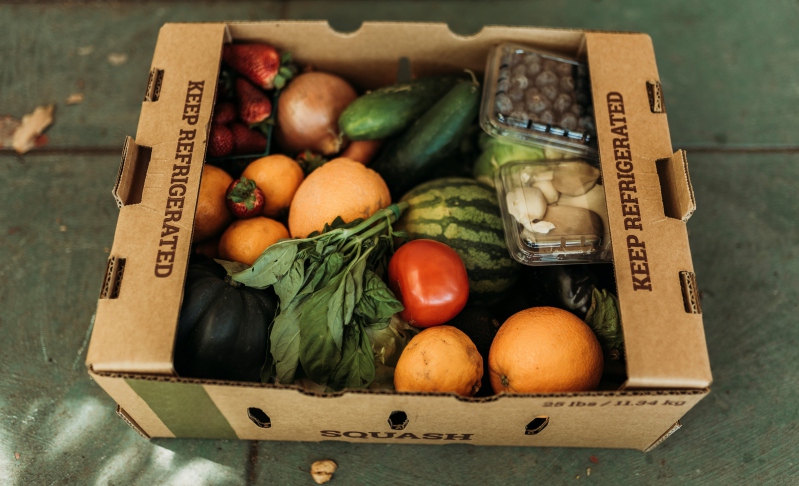
The pandemic highlighted the importance of food security and what policymakers should do to strengthen it.
The pandemic has served as a metaphorical earthquake that has stress tested the United States’ social safety net, especially federal anti-hunger programs.
Some of the most startling and grim images from the beginning of the COVID-19 pandemic were the miles-long lines outside of food banks as the economic toll of the crisis began to spread across the country. As schools closed down and businesses were shuttered, unemployment rates spiked to levels even higher than those during the Great Recession—and many families who had never struggled to put food on the table found themselves in desperate need of help.
In August, the U.S. Department of Agriculture announced that the Thrifty Food Plan, which is used to calculate monthly SNAP benefits, will get a long-overdue update to better reflect the cost of a nutritious diet. Yet, millions of eligible households each year do not apply for benefits and research suggests that administrative burdens and barriers to applying for benefits account for those gaps in participation.
According to researchers at Northwestern University, nearly one in four households experienced food insecurity in 2020. One federal program that rose to meet the moment to combat hunger is the Supplemental Nutrition Assistance Program (SNAP), but the pandemic has highlighted changes that policymakers should consider going forward after the pandemic to improve its performance.
The COVID-19 pandemic and past crises have provided lessons for how to modernize SNAP and increase its effectiveness as an anti-hunger intervention. As I put forth in a recent paper, policymakers should reduce barriers to applying for and remaining in the program for eligible households, target interventions for groups that have historically had low take-up rates, and reinforce SNAP as an “automatic stabilizer” to make the program and our social safety net more resilient for future crises.
SNAP—formerly known as the Food Stamp Program—is the United States’ single most effective and wide-reaching anti-hunger program. It subsidizes food purchases for nearly half of all Americans at some point during their lives and an estimated one in nine Americans in any given month. In 2019 alone, there were 38 million participants in the United States who received SNAP benefits, 44 percent of whom are children. The majority of SNAP recipients are working families with at least one worker.
Each additional step and requirement that enrollees face in the application process and to remain enrolled in SNAP decreases participation and increases costs through programmatic churn during periods of recertification. These bureaucratic hurdles have proven even more difficult during the pandemic.
Eligible households endure an extensive interview process, burdensome documentation requirements, and other more subtle costs, such as a sense of stigma in applying for and using benefits. According to the U.S. Department of Agriculture, the participation rate for eligible poor working families in 2017 was 73 percent, although there is significant variation among different populations and states. For example, the take-up rate in Wyoming was 52 percent but in New York City, approximately a quarter of eligible households, or 700,000 eligible people, do not receive benefits.
Research offers ways to fix these problems. Policymakers at the federal level should require states to create a single, straightforward application for multiple social safety net programs and make sure that it is available both online and offline. Policymakers should also reconsider the effectiveness and design of work requirements.
Lengthening the recertification window and making scheduling interviews more flexible would decrease churn and reduce administrative costs by giving low-income Americans who rely on SNAP more time to fit recertification into their work schedules and caregiving responsibilities.
Reforming counterproductive qualification limits on savings and assets—which have the unintended consequence of causing families to avoid rainy day funds—and requiring the use of broad-based categorical eligibility by all states would help streamline the program. For example, the Allowing Steady Savings by Eliminating Tests (ASSET) Act, introduced by U.S. Senators Chris Coons (D-Del.) and Sherrod Brown (D-Ohio), would remove these counterproductive limits.
Technology could also improve applicants’ experience and the recertification process to reduce churn in SNAP. Technological approaches should be tailored to address the particular barriers and vulnerabilities of certain groups, such as the elderly, rural communities, and college students.
Research suggests that age-specific informational barriers, coupled with low internet usage, are to blame for why only 42 percent of eligible elderly adults end up receiving benefits and why many drop out of the program during recertification windows. Interventions that increase awareness around eligibility and provide technical assistance have shown promise in increasing those numbers.
The Biden Administration should also encourage the U.S. Department of Agriculture to invest in innovative payment systems beyond those that allow transactions via electronic benefit transfer (EBT). New methods could allow SNAP recipients to use mobile wallets and chip cards to purchase food at stores, which could help eliminate social stigma and psychological costs for SNAP recipients.
U.S. policymakers should use the lessons from the COVID-19 pandemic and the Great Recession to ensure that Americans are better prepared to meet the next national emergency. Programs such as SNAP and unemployment insurance serve as countercyclical income boosts to families during downturns and this spending also benefits the economy as a whole, staving off some of the worst effects of economic downturns.
Throughout the pandemic, nearly 44 million individuals enrolled in SNAP—a more than 20 percent jump from about 36 million in 2019. Still, hungry families were forced to wait on Congress for relief despite historic levels of food insecurity.
Congress should pass the Food for Families in Crisis Act, introduced by U.S. Senator Michael Bennet (D-Colo.), that would reform SNAP by implementing an “economic trigger to jumpstart automatic stabilizers” if the economy meets certain conditions. If these conditions are met, SNAP would automatically increase by 15 percent until the economy recovers. In addition, the minimum benefit would increase to $30 and work requirements would be suspended for the duration of the crisis.
These proposals would help get aid to families quickly, especially to those breadwinners who experience job losses and are unable to find stable employment.
It is in our national interest to wield every possible intervention at curbing hunger in the United States. When people are hungry, it is harder for them to be healthy, productive members of society. Food insecurity is a widespread problem that afflicts the young and old and limits the economic potential of the most vulnerable among us. The successes and challenges of SNAP before and during the pandemic demonstrate the great opportunity for policymakers to reduce food insecurity by lowering administrative barriers and enhancing accessibility.




